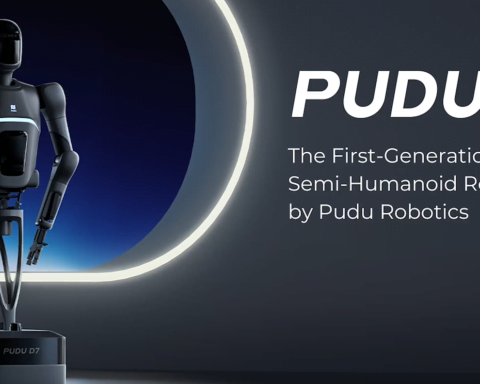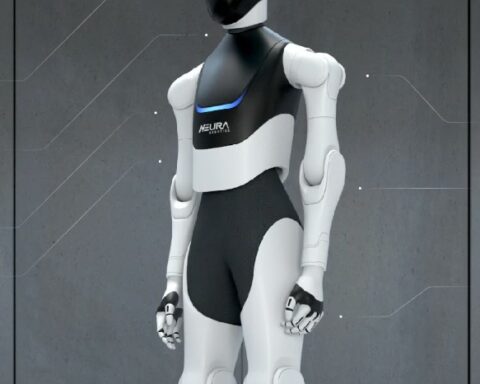Last Updated on December 2, 2024 1:47 pm by Laszlo Szabo / NowadAIs | Published on December 2, 2024 by Laszlo Szabo / NowadAIs
Cyberpunk Future Loading: Neuralink Robot Arm Controlled By Brain Chip – Key Notes:
- Neuralink has developed a brain chip that allows direct neural control of a robotic arm through sophisticated neural signal interpretation
- The technology aims to provide unprecedented autonomy for individuals with motor impairments
- Successful testing demonstrates the potential for seamless brain-machine interfaces in medical and potentially broader applications
Introduction To Neuralink And Its Brain Chip Technology
Neuralink, a neurotechnology company founded by Elon Musk in 2016, has emerged as a pioneer in the burgeoning field of brain-machine interfaces (BMIs). The company’s vision involves bridging the gap between human cognition and digital systems by developing advanced neural implants capable of interfacing directly with the brain. At the core of Neuralink’s mission is a tiny, sophisticated brain chip, often referred to as the “Link,” designed to interpret and transmit neural signals with remarkable precision. [Sources: 0, 1, 2]
This device is implanted into the brain through a minimally invasive surgical procedure that utilizes a specially designed robot capable of inserting thin, flexible threads—each thinner than a human hair—into regions of the brain responsible for various functions, including movement. [Sources: 3]
The ultimate goal of Neuralink’s technology is to enable seamless communication between the brain and external devices, thereby opening doors to new applications in both medical and non-medical fields. Initially, the focus is on providing therapeutic solutions for individuals with neurological disorders, such as paralysis or severe movement impairments. By translating neural activity into digital signals, the brain chip can facilitate control over prosthetic limbs, computers, or other electronic devices, offering individuals with disabilities unprecedented levels of autonomy. [Sources: 4, 5]
As Neuralink continues to refine its technology, the potential for enhancing human cognitive capabilities and even integrating artificial intelligence with the human brain remains a tantalizing prospect at the forefront of modern neuroscience. [Sources: 6]
The Development Of The Robot Arm Interface
We’re excited to announce the approval and launch of a new feasibility trial to extend BCI control using the N1 Implant to an investigational assistive robotic arm.
This is an important first step towards restoring not only digital freedom, but also physical freedom. More info…
— Neuralink (@neuralink) November 25, 2024
The development of the robot arm interface in Neuralink’s testing has marked a great step forward in the realm of brain-machine interfaces. This endeavor builds on decades of research aimed at enabling seamless interaction between human neural networks and robotic systems. Neuralink’s primary objective is to refine a system where implanted brain chips wirelessly transmit neural signals, allowing individuals to control robotic arms purely through mental intent. [Sources: 7, 8, 9]
This interface utilizes advanced algorithms designed to interpret and translate complex patterns of neural activity into precise movements of the robotic arm. The project faced numerous challenges, particularly in the realm of real-time processing and autonomy, where it was crucial to achieve minimal latency and accurate response to users’ brain signals. Enhancing the interface’s adaptability was a critical component of the development process, requiring rigorous testing to ensure the system’s ability to function across a diverse range of neural patterns and intentions. [Sources: 10]
Researchers focused on enhancing the connectivity between the brain chip and the robotic arm to achieve fluid, lifelike movements without compromising safety or reliability. Neuralink’s advancements in this area have opened new avenues in assistive technologies, offering remarkable potential for individuals with motor impairments. Beyond the immediate goal of robotic arm control, this technology promises to illuminate the vast possibilities of neural interfacing in augmenting human capabilities and experiences. [Sources: 2, 11]
How The Brain Chip Controls The Robotic Arm
The neuralink brain chip system enables direct communication between the brain and a robotic arm by translating neural activity into actionable commands. This totally new process begins with the implantation of a small, sophisticated device in the motor cortex, the brain region responsible for planning, controlling, and executing voluntary movements. The chip comprises tiny electrodes that detect electrical impulses generated by neurons as they fire. [Sources: 12, 13, 14]
When a person thinks about moving their arm, specific patterns of neural activity emerge, which are detected and recorded by the chip. [Sources: 15]
The data captured by the chip is wirelessly transmitted to an external computer for real-time processing. Advanced algorithms then decode the complex neural signals, translating them into precise instructions for the robotic arm. This involves interpreting the user’s intentions, such as reaching or grasping, and converting them into movements that mirror natural arm functions. The seamless integration of machine learning algorithms enhances the translation accuracy over time by adapting to individual users’ neural signatures and preferences. [Sources: 8, 16, 17, 18]
Feedback systems are crucial in refining control, providing sensory information back to the user, either through visual feedback from watching the arm or through haptic feedback devices. This loop enables continuous learning and adjustment, fostering greater dexterity and responsiveness. The result is a fluid interaction between the user’s thoughts and the robotic arm, transforming cognitive intention into physical action. [Sources: 19, 20]
Testing And Experimentation: Progress And Challenges
The testing and experimentation of the Neuralink’s brain chip, which aims to control a robot arm through direct neural inputs, represents a new intersection of neurotechnology and robotics. Progress in these experiments has been marked by small but significant steps towards understanding how the brain’s signals can be translated into precise mechanical movements. Initial tests have typically involved non-human subjects, as researchers work to refine the technology’s reliability and accuracy. [Sources: 21]
The chip is designed to decode neural impulses, translating them into commands that can maneuver a robotic limb with increasing sophistication. The challenges throughout these trials are substantial, requiring significant advancements in both the hardware of the implant and the software necessary for decoding complex neural activity. [Sources: 2, 22]
One of the most pressing challenges is achieving a high degree of precision and speed in movement. The neural interface must relay a vast amount of data in real-time to ensure smooth and coordinated actions, necessitating continuous improvements in both data transmission rates and signal clarity. Moreover, the brain-chip interface must operate over extended periods without degradation or causing harm to neural tissue. [Sources: 23]
Addressing these issues involves a multidisciplinary approach, encompassing neurobiology, materials science, and computer engineering. Despite these challenges, the ongoing experimentation remains promising, as each iteration brings the technology closer to practical, real-world applications, aiming to offer life-changing benefits for individuals with motor impairments. [Sources: 1, 24]
Potential Applications And Implications Of Mind-Controlled Robotics
The development of mind-controlled robotics, as demonstrated by Neuralink’s successful tests of a robot arm controlled by a brain chip, presents a wide range of potential applications and implications that could significantly transform both medical and non-medical fields. In the medical arena, such technology holds the promise of restoring mobility and independence to individuals who have suffered from paralysis due to spinal cord injuries, strokes, or neurodegenerative diseases. [Sources: 10, 25]
By directly interfacing with the brain, these robotic systems can bypass damaged neural pathways, offering new hope for rehabilitation and quality of life improvement. [Sources: 26]
Beyond medical uses, mind-controlled robotics could revolutionize human-machine interactions in industrial settings. Workers equipped with brain interfaces could operate heavy machinery in hazardous environments without physical contact, thereby reducing the risk of injury and enhancing productivity. In addition, this technology could empower people with disabilities to engage in professional and personal activities, furthering societal inclusivity. [Sources: 27, 28]
The implications of mind-controlled technology extend into ethical and security spheres. The prospect of direct brain-machine communication raises questions about data privacy, consent, and the possibility of cybernetic manipulation. Ensuring that such technologies are developed and implemented responsibly will be pivotal. As science and technology continue to advance, the integration of neural interfaces with robotics will likely shape future interactions between humans and machines in profound and unforeseen ways. [Sources: 4, 22, 29, 30]
Ethical Considerations And Future Directions For Neuralink
The ethical considerations surrounding Neuralink’s advancements, such as the development of a robot arm controlled by a brain chip, are substantial and multifaceted. At the core lies the need to balance revolutionary medical potential with moral responsibility. The prospect of restoring functionality to individuals with paralysis or neurodegenerative diseases is inspiring, yet it raises significant ethical concerns about safety, consent, and long-term impacts. [Sources: 8, 31]
Ensuring that brain chip technology is safe and that informed consent is genuinely informed, free from coercion, is paramount. Additionally, there are concerns about privacy and data security, as Neuralink’s devices could potentially access and store sensitive neural data. It is crucial to protect this information from misuse or unauthorized access. [Sources: 8, 10, 32]
The pursuit to enhance human capabilities also prompts questions about equity and accessibility. There is a risk of widening socioeconomic divides if only a privileged few can access these technologies. Moreover, philosophical and ethical debates emerge about altering human cognition and capabilities, potentially challenging existing notions of identity and human experience. [Sources: 22, 33]
Looking to the future, it is essential for Neuralink to maintain a dialogue with ethicists, scientists, and the public to address these issues responsibly. Through transparent practices, ongoing assessments, and regulatory frameworks, Neuralink can navigate these complex terrains, ultimately maximizing the benefits of brain-machine interfaces while minimizing potential harms. [Sources: 14, 34]
Descriptions
Terms Needing Explanation:
- Brain-Machine Interface (BMI): A direct communication pathway between the brain’s neural networks and an external device, allowing thoughts to control mechanical systems.
- Motor Cortex: The region of the brain responsible for planning, controlling, and executing voluntary movements. It generates specific neural activity patterns when a person intends to move.
- Neural Signals: Electrical impulses generated by neurons (brain cells) that carry information within the nervous system. In this context, these signals can be detected and translated into mechanical commands.
- Electrodes: Tiny conductive elements that can detect electrical activity in the brain, acting as sensors that pick up neural signals.
- Wireless Transmission: The ability to send data from the brain chip to an external computer without physical connections, using radio or similar wireless communication technologies.
- Machine Learning Algorithms: Computer programs that can improve their performance on a specific task through experience, in this case, learning to better interpret an individual’s unique neural patterns.
- Haptic Feedback: A technology that creates a sense of touch by applying forces, vibrations, or motions to the user, helping provide sensory information about the robotic arm’s movements.
- Neural Implant: A small electronic device surgically placed within brain tissue to record or stimulate neural activity.
Sources
[0]: https://www.findlight.net/blog/neuralink-technology/
[1]: https://yipinstitute.org/policy/neural-implants-the-future-of-healthcare
[5]: https://www.engineersgarage.com/what-is-neuralink/
[6]: https://www.laparoscopyhospital.com/news/preview.php?id=297&p=&search=
[7]: https://readaloudforme.com/
[12]: https://fiveable.me/key-terms/biophotonics-and-optical-biosensors/brain-controlled-robotics
[13]: https://atm.amegroups.org/article/view/33229/html
[15]: https://www.denisonforum.org/daily-article/elon-musks-neuralink-implants-brain-chip-in-human/
[17]: https://uokerbala.edu.iq/en/what-are-neuralink-chips-and-what-are-their-applications/
[18]: https://www.linkedin.com/pulse/neuralink-testing-robotic-arm-control-youssef-sabrallah-4xg1e
[19]: https://jneuroengrehab.biomedcentral.com/articles/10.1186/s12984-021-00820-8
[20]: https://www.azorobotics.com/Article.aspx?ArticleID=171
[22]: https://www.findlight.net/blog/neuralink-capabilities/
[23]: https://en.wikipedia.org/wiki/Brain%E2%80%93computer_interface
[24]: https://suchscience.net/elon-musk-brain-chip/
[25]: https://pmc.ncbi.nlm.nih.gov/articles/PMC2645562/
[26]: https://www.mountbonnell.info/neural-nexus/the-role-of-robotics-in-neuralinks-manufacturing-process
[28]: https://www.thelogcchs.com/post/neuralink-a-glimpse-into-the-future-of-technology
[30]: https://www.mountbonnell.info/neural-nexus/neuralink-meets-robotics












